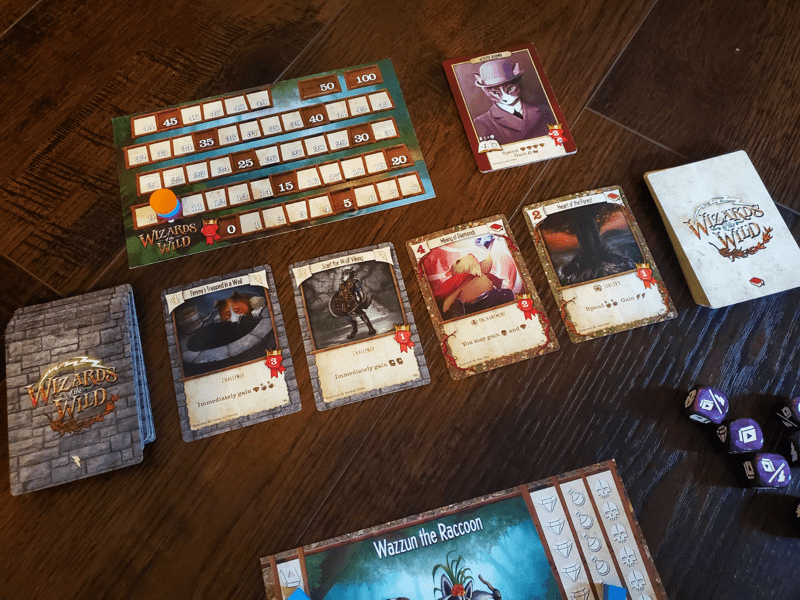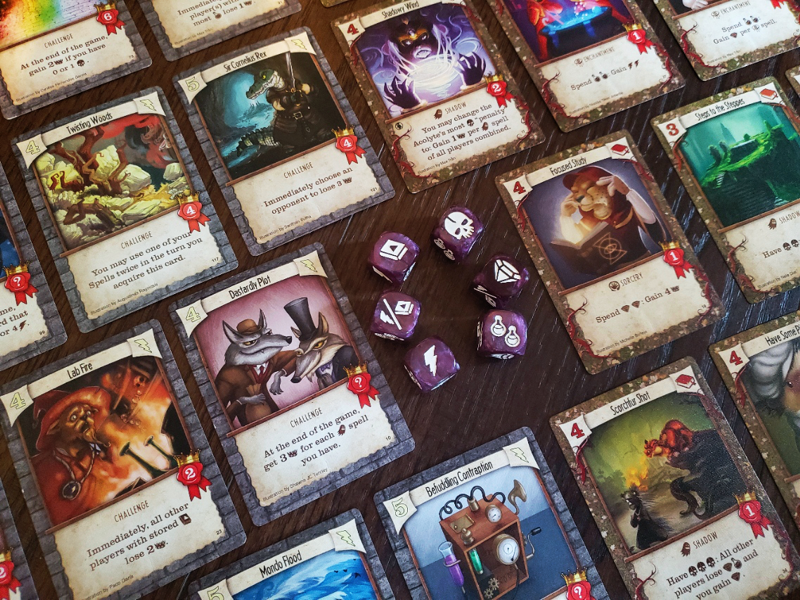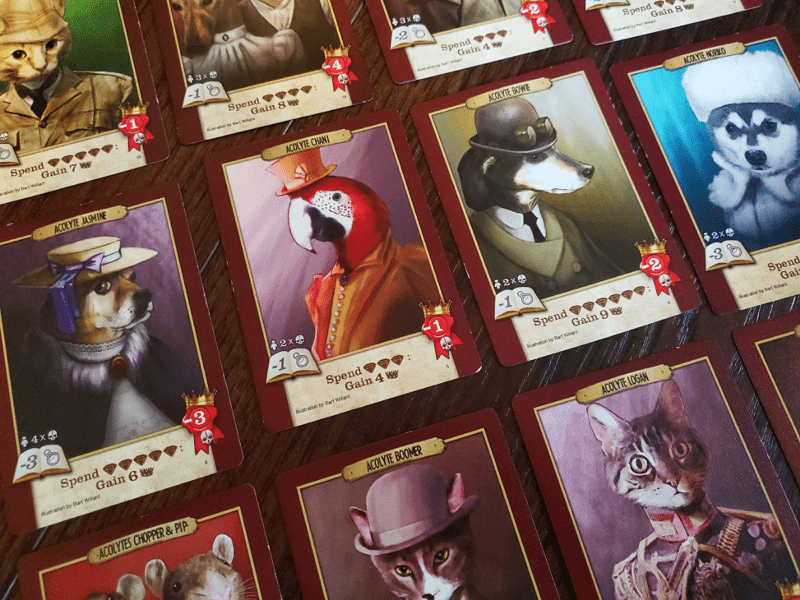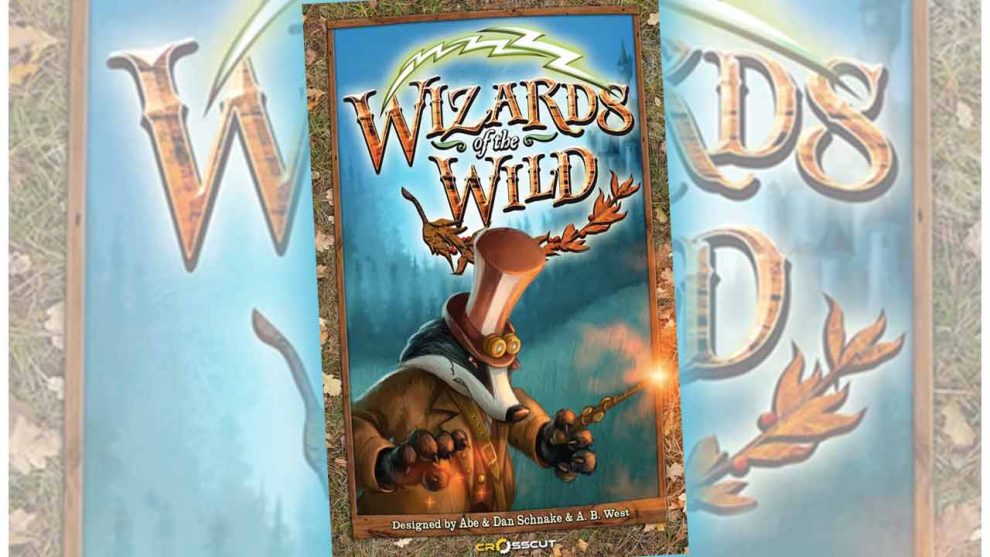I still remember the day I purchased Wizards of the Wild. I guess you could call it an impulse buy, like a pack of gum or a PayDay bar. As I was waiting at the checkout of a local game store, peeking at the small box and card games, I saw a well-dressed and rather magical-looking badger staring up at me. As a fan of all games critterly, I picked up the box. I can’t say I looked all that closely before I tossed it on the stack and handed over the necessary cash.
I love small box games, in part because of Wizards of the Wild. That fateful impulse buy proved what sort of unexpected enjoyment can come from judging a book by its cover and taking a chance. I’ll admit such gambles have rarely paid off with such success, but I’ve found a number of favorites by not overthinking the deal and taking the leap at (but not over) the retail counter.
Wizards of the Wild is the creation of Dan and Abe Schnake and Adam West, the team behind Ninjato and Deadline. With two successful Kickstarters under its belt—one for the base game and another for the Forbidden Forest expansion—West’s CrossCut Games has carved a niche with this title that I find quite cozy.
The story is a familiar one. Humanity has disappeared, leaving suddenly magical critters to battle for supremacy. The even better-dressed Acolytes of the old way (former pets) hold devious contests among the wizards and exert their questionable authority. Let’s grab our cards and dice and get to work.
I always knew the cats were plotting against us
Players begin by selecting their critterly Wizard and choosing a side of their card to utilize. Each Wizard has two special abilities, one of which they can exercise throughout the game. Players also choose a color for their markers, setting them to the base values indicated on the card.

Two decks are organized and set between the Wizards—Spells and Challenges—with two cards from each forming a face-up market between. A smaller deck of seven Acolyte cards rest nearby to mark the conditions for each round of the game.
At the beginning of each round, a new Acolyte is revealed who punishes the Wizards by taking away a number of Mana. If the Mana value reaches zero before payment is complete, Skulls are added to exact a toll. Each Acolyte can be bribed during the round with a certain number of Gems in exchange for Victory Points.

One by one, the players then receive the six Sorcery dice to roll three times, each time keeping any dice that suit their fancy. Rolled Skulls are recorded and then re-rolled with the next toss just to maximize the possibility of more. Once the rolls are complete, the dice are combined with the stored values on the Wizard card to exercise Spells, hit the Market, and Bribe the Acolyte in any order.
The Market consists of those Spells and Challenges. Spells are purchased using Tomes collected via the dice, other Spells, and the occasional Challenge card. Challenges are purchased using Arcane (symbolized as Lightning) and grant single-use and endgame bonuses. Players may purchase as many cards as they are able, bringing them into immediate service. If no purchase is made, each Wizard has the capacity to store three Tomes and three Arcane for future rounds.
Spells typically exchange some cost—most often in Mana and Skulls—for a benefit. Benefits could result in adding Tomes and Arcane to spend in the Market, additional Gems for the Bribe, or some strange swing of Victory Points. Each Spell can be cast once per round.

Spells are divided into three types. Shadow spells love skulls and sometimes enact nasty effects on other players as an offset for taking the Acolyte penalty. Sorcery and Enchantment Spells tend to focus on building up the stores for effective combinations. The key to the game is capitalizing on the Market offerings to build an engine of these card relationships capable of propelling your Wizard to victory.
When a turn is complete, the dice are passed and the next player replenishes the Market with cards from either deck according to their choice. If no purchase was made, they discard one card and replenish to keep the options fresh.
At the conclusion of each round, the player with the most Skulls is penalized by the Acolyte through the loss of points. The first player rotates clockwise and another round begins. Following the seventh round, scores are tallied from each card’s value and one Wizard steps to the fore as the champion.
Wandering the Forbidden Forest
The Forbidden Forest expansion, in addition to new cards that supplement the original mechanics, adds two features to the base game.
Familiars are even smaller, even cuter critters that serve as a sidekick to the Wizard. Each familiar is a two-sided card with different effects front and back. When the effect of the Sun side is triggered, the card flips to the Moon and vice versa. Familiars create a give and take that can sometimes shift multiple times in a single turn, creating even deeper combinations.

Location cards modify the landscape of the battle temporarily. When introduced, the Location unleashes an effect on the game—restricting resources, discounting Market prices, granting Victory Points, etc—until a specific condition is reached, at which point a new Location is revealed for the coming round.
Tome sweet tome
Wizards of the Wild is rather simple in its mechanics. Replenish, Roll, Activate cards, make purchases, try to Bribe the fancy cat, and keep it moving. But that’s what I love—that, and the absurd thematic premise. These critters are anthropomorphic and utterly charming from top to bottom. Shawna J.C. Tenney (Creature Comforts, Winner Winner Chicken Dinner) knocked the artwork out of the park for this title. Each card has a unique illustration and they are all worth paw-sing to take a look.
The dice are easy to read and fun to toss. The five possibilities (the sixth side is an Arcane/Tome choice) are carved into beautiful purple resin with clear iconography. What more could I ask?
Because the Spell and Challenge decks run deep and offer such variety, Wizards of the Wild has room for the reclusive types who love to do magic from within their tidy invisible fortress and the bold types who love to get out and wreak a bit of havoc. There are plenty of strategies and paths to victory in this magical tournament. And because the Challenge cards and their point values are buried after purchase, you’re never quite sure who will come out on top until the final tally.
The expansions are relatively seamless, only making the game’s riches more accessible and giving each round a touch of flavor. They add nothing to the length and feel like a natural part of the world.
My love for this small box comes with but a single caveat: downtime. Apart from the occasional effect that causes you to move a cube or two, there is very little to do when it’s not your turn. In a two-player game, the time is negligible—it will be your turn again soon enough and the whole game lasts under 30 minutes. I find the three-player affair to be the most enjoyable, largely because it’s more fun when your Spells and Challenges impact multiple Wizards. If you venture into four and five player outings, though, brace yourself for significant waiting as the total time nears an hour.
That being said, Wizards of the Wild is the sort of game that can be played quite casually with conversation. Baxel the Bear isn’t going to send your brain into a spiral of self-doubt and anguish over whether to save the Arcane die or the Gem. Neither will Wazzun the Raccoon demand such concentration that you must hush the room. If you’re the kind of player who enjoys a game as an opportunity to catch up with friends or wax philosophical, you might just find this critterly contest to be the perfect vehicle. You can take a breath from your discussion of Chesterton and Wells to critique the clothing of the newest Acolyte before hitting the French press and diving in again.

There is a solo option that pits the player against another Wizard who begins with a certain number of points that can dwindle throughout the game by strategic advances. The Acolyte cards assign Skulls to the solo player for determining the penalties, which are then administered with the help of the dice. The Market cards are entirely wiped out at the end of each round, keeping the options consistently fresh. Otherwise, play is largely the same effort to maximize combinations for Victory Points in pursuit of the opposing Wizard’s tally.
Personally, I play with my kids. They adore this game. I love the time around the table, working my way through the various Wizards and their various abilities to see what sorts of combinations I can build. I welcome the downtime to ask about their day or just spend the whole time talking creaturely smack as I heap up Skulls on my Shadow Spells—depends on my mood.
Wizards of the Wild is one of those games I never refuse. I know it’s not perfect. It’s not a knock-down-drag-out fight, nor is it a forest fire for the mind. But it speaks my language. The critters, the world, the story, the art, the lovely combinations, and the simplicity of the time around the table all add up to a winner in our Tome.











Add Comment